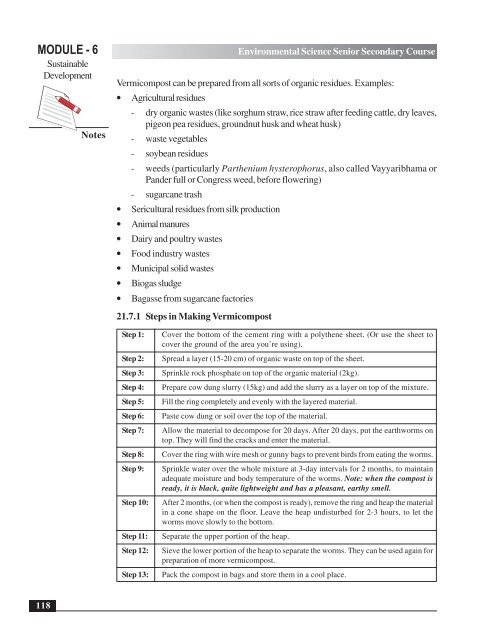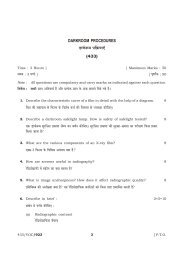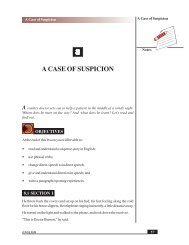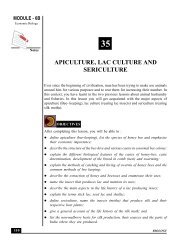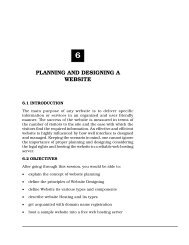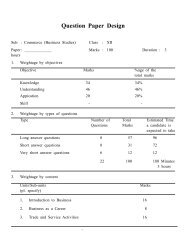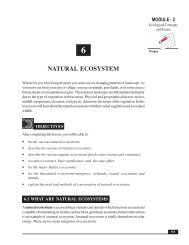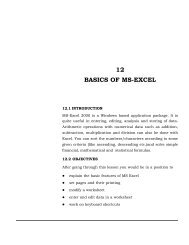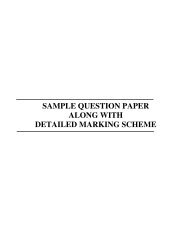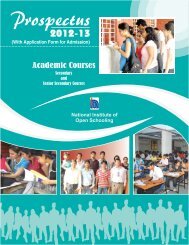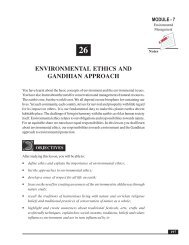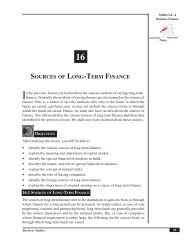<strong>Concept</strong> <strong>of</strong> <strong>Sustainable</strong> <strong>Agriculture</strong>weeds, insects, and disease organisms. Weeds are controlled through crop rotation,mechanical tillage, and hand-weeding, as well as through cover crops, mulches, flameweeding, and other management methods. Organic farmers rely on a diverse population <strong>of</strong>soil organisms, beneficial insects, and birds to keep pests in check. When pest populationsget out <strong>of</strong> balance, growers implement a variety <strong>of</strong> strategies such as the use <strong>of</strong> insectpredators, mating disruption, traps and barriers.MODULE - 6<strong>Sustainable</strong>DevelopmentNotesSome important benefits for organic farming and organic foods:• Organic farming is a science in itself which can be learnt easily by any conventionalfarmer.• It has been found that by switching to organic farming, conventional farmer can actuallyreduce its production cost by over 25% as compared to the cost <strong>of</strong> conventionalfarming. This is eliminate the use <strong>of</strong> expensive synthetic fertilizers and pesticides,minimizing soil erosion by up to 50% and increasing crop yields up to five-folds.• A well planned transition strategy may allow conventional farmers to adopt new, moreeffective organic farming practices easily.• Organic farms can support substantially higher levels <strong>of</strong> wildlife especially in low landsand where animals can roam in pastures or graze on grassland. Not only does wildlifebenefit, but entire ecosystems and ground water are improved by simply followingorganic farming methods.• Organic farming practices not only benefit farmers and consumers; but the dairies canbenefit. When dairies feed their cows organic feed and graze them on organic fields,the cows experience better health, less sickness, diseases and ultimately produce bettertasting milk for consumers.• Organic farming promotes healthy soils that are teaming with life and rich in micronutrients and which can be used for decades to grow crops without getting exhausted.• Consumers purchasing organically grown foods are tastier. Regardless <strong>of</strong> minimal pricedifferences, consumers can smell, taste and see the difference in the quality <strong>of</strong> organicallygrown food products.• Organically grown products are free from harmful chemicals, artificial flavors andpreservatives that ultimately cost consumers more money than non-organically grownproducts. You can always taste the difference between organically grown andconventionally grown products.21.7 VERMICOMPOSTVermicomposting is an appropriate technique for efficient recycling <strong>of</strong> animal wastes, cropresidues and agro-industrial wastes. The process <strong>of</strong> conversion <strong>of</strong> organic materials intomanure is chiefly microbiological. Earthworms are important for producing vermicompostfrom organic wastes.117
MODULE - 6<strong>Sustainable</strong>DevelopmentNotesEnvironmental Science Senior Secondary CourseVermicompost can be prepared from all sorts <strong>of</strong> organic residues. Examples:• Agricultural residues- dry organic wastes (like sorghum straw, rice straw after feeding cattle, dry leaves,pigeon pea residues, groundnut husk and wheat husk)- waste vegetables- soybean residues- weeds (particularly Parthenium hysterophorus, also called Vayyaribhama orPander full or Congress weed, before flowering)- sugarcane trash• Sericultural residues from silk production• Animal manures• Dairy and poultry wastes• Food industry wastes• Municipal solid wastes• Biogas sludge• Bagasse from sugarcane factories21.7.1 Steps in Making VermicompostStep 1:Step 2:Step 3:Step 4:Step 5:Step 6:Step 7:Step 8:Step 9:Step 10:Step 11:Step 12:Step 13:Cover the bottom <strong>of</strong> the cement ring with a polythene sheet. (Or use the sheet tocover the ground <strong>of</strong> the area you’re using).Spread a layer (15-20 cm) <strong>of</strong> organic waste on top <strong>of</strong> the sheet.Sprinkle rock phosphate on top <strong>of</strong> the organic material (2kg).Prepare cow dung slurry (15kg) and add the slurry as a layer on top <strong>of</strong> the mixture.Fill the ring completely and evenly with the layered material.Paste cow dung or soil over the top <strong>of</strong> the material.Allow the material to decompose for 20 days. After 20 days, put the earthworms ontop. They will find the cracks and enter the material.Cover the ring with wire mesh or gunny bags to prevent birds from eating the worms.Sprinkle water over the whole mixture at 3-day intervals for 2 months, to maintainadequate moisture and body temperature <strong>of</strong> the worms. Note: when the compost isready, it is black, quite lightweight and has a pleasant, earthy smell.After 2 months, (or when the compost is ready), remove the ring and heap the materialin a cone shape on the floor. Leave the heap undisturbed for 2-3 hours, to let theworms move slowly to the bottom.Separate the upper portion <strong>of</strong> the heap.Sieve the lower portion <strong>of</strong> the heap to separate the worms. They can be used again forpreparation <strong>of</strong> more vermicompost.Pack the compost in bags and store them in a cool place.118


